The Dust Bowl stories of a Mount Holyoke alumna

Alumnae Quarterly article, Caroline Boa Henderson, class of 1901, gave readers a glimpse of a little-known world — farming during the Dust Bowl decade. From 1930 to 1940, prolonged drought, unrelenting dust storms and widespread economic depression gripped parts of Texas, New Mexico, Colorado, Nebraska, Kansas and Oklahoma. The Dust Bowl spun into one of the worst environmental disasters in United States history, killing locals, crushing livelihoods and causing the largest U.S. migration ever recorded when 2.5 million people were driven from their homes.
Homesteaders like Henderson were drawn to the area by federal policies selling the idea that hard work could earn them land and a living. After leaving Mount Holyoke, Henderson went west to teach, but, after a near-fatal bout of diphtheria, she decided to stake a claim — as a single woman — in a remote slice of the Great Plains marked on maps as “No Man’s Land.” She was driven also by a strong Jeffersonian agrarianism that put agriculture at the center of American democracy and regarded farmers as morally superior and economically and politically independent.

Caroline Henderson in her graduation cap and gown. Photo courtesy David E. Grandstaff, Eleanor Grandstaff Collection.
The Hendersons, including Caroline’s husband, Will, and daughter Eleanor, were among the few families to withstand the physical and mental hardships brought on by unusually harsh atmospheric and social conditions. By the early 1930s Caroline and Will Henderson had been homesteading in the Oklahoma panhandle for 26 years, a hardscrabble existence not well understood by the rest of the country. “Most of my friends and relatives are city people. Of numerous farm-reared kindred in both lines of ancestry, I am the solitary one having still a direct connection with the soil,” she wrote in the Alumnae Quarterly.
In 1908 Henderson explained the idealistic move in a letter to classmate Rose Alden. “A return to the old routine seemed intolerable. I hungered and I thirsted for something away from it all and for the out-of-doors. So here I am, away out in that narrow strip of Oklahoma between Kansas and the Panhandle of Texas, ‘holding down’ one of the prettiest claims in the Beaver County strip. I wish you could see this wide, free western country, with its great stretches of almost level prairies, covered with the thick, short buffalo grass, the marvelous glory of its sunrises and sunsets, the brilliancy of its starlit sky at night.” Henderson’s letter to Alden was one of dozens the friends would exchange over the next 50 years. Their correspondence is now housed in the College’s Archives and Special Collections.
By the time of the 1934 Alumnae Quarterly article, Henderson had already attracted a national following with her depictions of life on the Great Plains. After the drought and failed crop of 1912–1913, in order to supplement her young family’s fluctuating income, Henderson started writing about her life on the 160-acre homestead in a 14-foot by 16-foot uninsulated, one-room house. In the beginning she wrote for Practical Farmer and penned a popular column called “Homestead Lady” for Ladies’ World Magazine. Even early on she alternated between hope and fear, delight and despair. And while she expressed wonder at the singular beauty of her homestead, she also introduced readers to the day-to-day drudgery of life on the farm. Her daily chores included tending a huge garden, grinding wheat for flour and cereal, helping with harvests, herding cattle, churning butter, assisting with calf births, repairing farm equipment, cooking and cleaning. Henderson wrote poignantly about the snowbirds and meadowlarks, the delicious dampness of spring, and the impact nature had on her well-being. She also wrote about her affinity for the land, her pride in self-sufficiency, the exhaustion of living off the land, a desire for fairness, and the struggle to maintain dignity despite dire conditions.
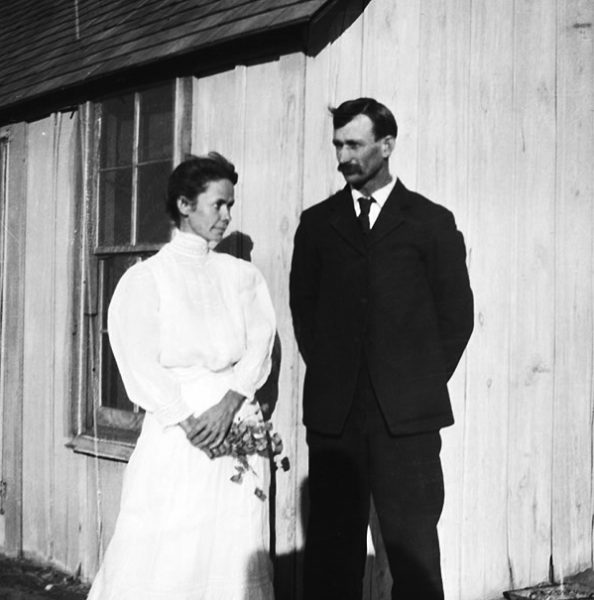
Caroline and Will Henderson on their wedding day. Photo courtesy David E. Grandstaff, Eleanor Grandstaff Collection.
Henderson wrote candidly about suffering low moods and impatience (such as when she asked her husband to get iodine for a frostbitten foot at the general store 30 miles away, and he returned with sardines instead). She often felt isolated on the farm, sometimes not seeing passersby for days, and she sometimes went years without going into a town. Doubt was ever-present, and they worried about failure when droughts, blizzards, hail storms or grasshoppers got the best of the crop. “We are hoping that the years to come may prove that our faith in the future of our big lonely country was not mistaken,” she wrote in a letter to Alden in 1912.
A year later she wrote, “For a time I felt very rebellious and very unwilling to waste any more time or strength in trying to make this particular part of the desert rejoice. Whether wisely or not I do not know, we’ve decided to try our fortunes here one more year.” Sporadic prosperous years on the farm encouraged the family to stick it out. “The fascination of being so near the beginning of things, of finding ourselves not quite mastered by various calamities, has held us. We have always felt that if we could hold out for a few more years we should succeed; our homestead would really become a home,” she wrote in July 1913 to the editor of Ladies’ World Magazine.

Henderson wrote some of the most vivid accounts of the American experience at that moment in history, drawing a portrait of those who stayed on their farms and struggled to survive. Some of the colorful correspondence with Alden formed the basis for her “Letters from the Dust Bowl” published from 1931 to 1937 in the Atlantic Monthly.

Henderson in Texas County, Oklahoma. Photo courtesy David E. Grandstaff, Eleanor Grandstaff Collection.
Standing with one foot in the pulverized soil of the Oklahoma panhandle, and the other among the East Coast intelligentsia, Henderson had a uniquely appealing voice.
In a letter to Alden in December 1931, Henderson downplayed her success in landing in the high profile magazine. “It really seemed as if someone ought to try to suggest the human side of the wheat situation and it was, I think, only a fortunate accident that caused the acceptance of so matter-of-fact a narrative,” she wrote. Henderson wrote for the Atlantic Monthly, in large part, to offer a more realistic picture of the independent farmer who she felt, up to that point, had been mischaracterized as living off the “free bounty of the earth.” Despite the fact that many readers might have disagreed with her up to that point, Henderson didn’t shy away from topics such as unfairness in agricultural pricing and the dire consequences for farmers as each day dawned with more blasting wind, 120-degree heat and wilting drought.
“Her writing is very direct, very evocative. When she talks about the Dust Bowl, all the privations come through,” says David Grandstaff, a geochemist at Temple University and Henderson’s grandson. She described living with handkerchiefs tied over their faces and Vaseline coating their nostrils in an attempt to avoid inhaling irritating dust. Getting water or milk to the house without a coating of dust was impossible, and no effort to seal windows or doors (even with sheets coated with kerosene) was completely effective; even the butter inside the refrigerator would be coated with it. She swept the “silt-like deposit” out of the bathtub and off the kitchen floor where it was thick enough at times to form ripples. “Nothing that you see or hear or read will be likely to exaggerate the physical discomfort or material losses due to these storms,” she wrote in March 1936. Thousands of people were sickened or killed by ‘dust pneumonia’ during the Dust Bowl.
Now in his early 70s, Grandstaff spent summers on the family’s farm from fifth grade through high school. He chopped wood, fed the chickens, collected eggs and occasionally drove the tractor. He gained an appreciation for how difficult life was for his grandparents and mother. “It’s hard land, it’s the toughest. … They lived on the rawer edge of things.” No matter how much they prayed, tightened their belts, or planted trees as windbreaks, there was little the Hendersons could do about the weather or crop prices. “In nothing that we can produce here is there at present the slightest chance of any return on our labor. Yet we keep on working — really harder than ever,” she wrote in the Atlantic Monthly in 1933. “But of all our losses in recent years the most distressing is the loss of our self-respect. How can we feel that our work here has any dignity or importance when the world places so low a value on the products of our toil? We are humiliated,” she wrote.
“We are hoping that the years to come may prove that our faith in the future of our big lonely country was not mistaken.”Caroline Boa Henderson, in a letter to classmate Rose Alden
In her Alumnae Quarterly piece, Henderson called the early 1930s a “period of almost chaotic darkness,” but the worst was yet to come. Dozens of dust storms had choked the Great Plains by the time alums would have read Henderson’s article, but it was a phenomenon that people in the East would soon experience firsthand. In the same month Henderson’s Alumnae Quarterly article was published, a two-mile-high “roller” (as High Plains locals called them) of more than 350 million tons of topsoil swept across the nation, coating Boston, New York and Washington.
The New York Times on May 12, 1934, described five hours of “half light,” like a partial eclipse due to dust that “seemed to have lodged itself in the eyes and throats of weeping and coughing New Yorkers.” The Springfield Union (MA) headline read: “New England Skies Darkened as Storm Is Whirled Here from Parched Farm Lands.” The captain of a ship off Nantucket remarked that the gray air reminded him of sailing off Africa, where the Sahara Desert sand blew hundreds of miles out to sea. At Mount Holyoke, they might have wondered if the Hendersons’ own acres were among the eerie “red” snow drifts in the winter of 1934-35, and in the dust they swept from porches.
As farmers despaired, and the federal government rolled out relief efforts and soil conservation schemes (both of which the Hendersons embraced, in spirit and practice), some East Coast publications saw fit to chastise those who were suffering. In her Alumnae Quarterly piece, Henderson took umbrage with the idea that farmers were sitting back and taking government handouts (some programs paid them to let their fields lie fallow). She took ownership for the role farmers played in their own fates, as she did many times in her writing. “The demands of the soil itself for fair treatment, for intelligent tillage and maintenance of fertility impress upon sensitive minds the discipline of a certain primitive justice,” she wrote.

In reality, several factors converged to cause the Dust Bowl — some due to human activities and others due to extreme climatic variations. “The Dust Bowl happened for a perfect storm set of reasons,” says Alan Werner, Mount Holyoke professor of geology and climate change specialist. The first decades of the 20th century were wetter than average on the semi-arid Great Plains, he says, which gave settlers an unrealistic picture of its suitability for agriculture. The adage “rain follows the plow” seemed more fact than folklore, and thousands more people flocked to the area. Government incentives and higher crop prices during World War I also encouraged farmers to plow under more than 5 million acres of native grassland to grow wheat.
“The big problem was that the natural vegetation — which, over geologic time, had adapted to that environment — was replaced by fields. Where the native vegetation was good at withstanding drought, the plowed fields were not,” says Werner. The Oklahoma Panhandle was never a temperate place (Henderson wrote even in the early years about fierce blizzards and crippling heat), but weather patterns shifted in the late 1920s to worsen the heat and drought. Thirsty crops withered and died, and then the winds came. Without the deeply rooted grasses that held soil and moisture in past droughts, the fertile top soil simply blew away.
The physical reality of the drought and dust storms caused mental anguish as fields and futures evaporated. In a 1935 letter to U.S. Secretary of Agriculture Henry A. Wallace, Henderson described the worsening conditions as her family longed for rain. After reminiscing about their years of relative abundance in the mid-1920s, she wrote, “Yet now our daily physical torture, confusion of mind, gradual wearing down of courage, seem to make that long continued hope look like a vanishing dream. … We dream of the faint gurgling sound of dry soil sucking in the grateful moisture of the early or later rains; of the fresh green of sprouting wheat or barley, the reddish bronze of springing rye. But we waken to another day of wind and dust and hopes deferred.”
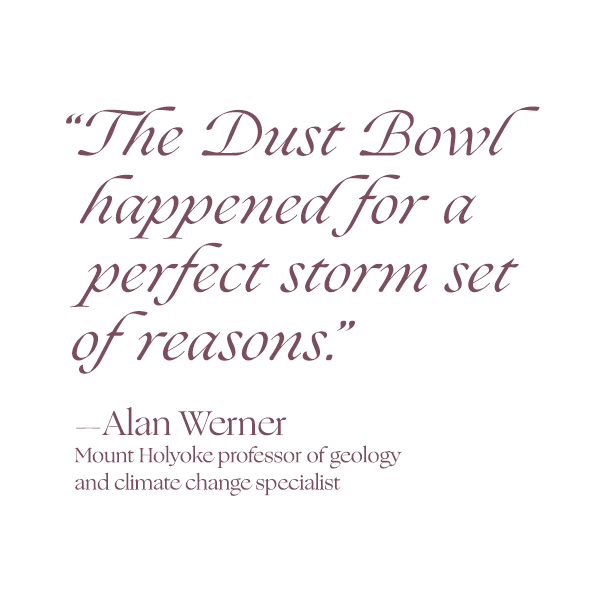
In May of 1936 Wallace responded, praising Henderson’s contribution to national “understanding of some of our farm problems and the courage with which farmers are meeting them.” He said she drew the attention of urban industrialized Americans to the “changing, and in many ways diminishing place of agriculture in the American economy and vision.” In that same month, in the Atlantic Monthly, Henderson responded to a question on the minds of many outsiders: “Why not pick up and leave as so many others have done? It is a fair question but a hard one to answer. … To leave voluntarily — to break all these closely knit ties for the sake of a possibly greater comfort elsewhere seems like defaulting on our task. We may have to leave. … But I think I can never go willingly or without pain that as yet seems unendurable.”
Grandstaff recalls the tight-knit group his grandparents were loath to abandon. They helped each other with crops and children and went caroling from house to house during the holidays; the glow of distant farmhouses was always a comfort to his grandmother on the lonely plains. “They developed strong bonds with neighbors, and she appreciated the community,” he says. Besides, even for tough, resourceful people like the Hendersons, prospects were limited elsewhere, says Grandstaff. The nation was still gripped by the Great Depression, and neighbors who migrated elsewhere, mainly California, were met with suspicion and discrimination. Many were settled into camps, while others were homeless.
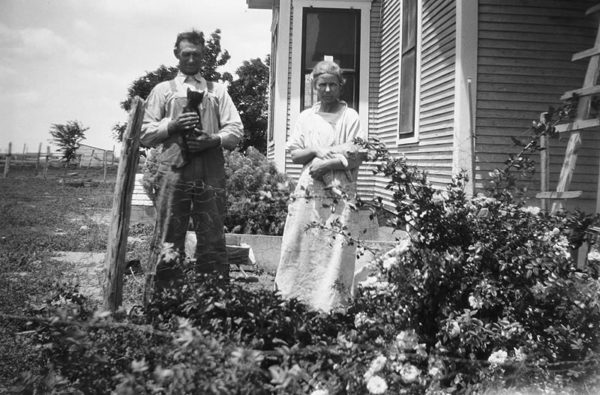
Caroline and Will Henderson at their home in Texas County, Oklahoma. Photo courtesy David E. Grandstaff, Eleanor Grandstaff Collection.
Will Henderson was remarkably handy, remembers his grandson, and Caroline could stretch a penny further than anyone — and had a memorable toughness. “She was very strong-willed,” says Grandstaff. In the mid-1930s, the Hendersons’ dream of living a full, abundant life was nearly gone, but they persevered — surviving on stored grain and what little they could harvest, while clearing dust from their eyes and beds. “They stuck it out for a long time,” says Grandstaff. Back then, Henderson wrote, “We can’t help questioning whether the traits we would rather think of as courage and perseverance are not actually recklessness and inertia. … We long for the garden and little chickens, the trees and birds and wild flowers of the years gone by,” she said. “They really loved nature, but the terrible conditions seriously affected her. It was pretty awful,” says Grandstaff.
The Hendersons remained on the farm, and conditions began to improve with the end of the Dust Bowl in 1940. They were rewarded, in a way, for keeping to the path they had forged decades earlier, but the experience had taken a toll. Some years that followed were a financial boon, but anxiety and ailments were ever-present. Will died on the farm in 1966, and Caroline died five months later. Their grandson still owns the land, but it was never again tilled, as was Caroline’s wish.
Henderson wrote in the 1934 Alumnae Quarterly, “It does not seem unreasonable to me to hope that people so constrained by the very conditions of their lives to value honest labor, fair dealing, improved means of production, and a just distribution of the earth’s bounty should exert a compelling influence in bringing in a new day of justice and opportunity for our own America and for the world.” Her “Letters from the Dust Bowl” in the Atlantic Monthly did that by communicating farmers’ plight in a way others had not. And they were, then as now, “lessons from the Dust Bowl” about people and nature, conflict, idealism, versatility and the supremacy of weather and climate.
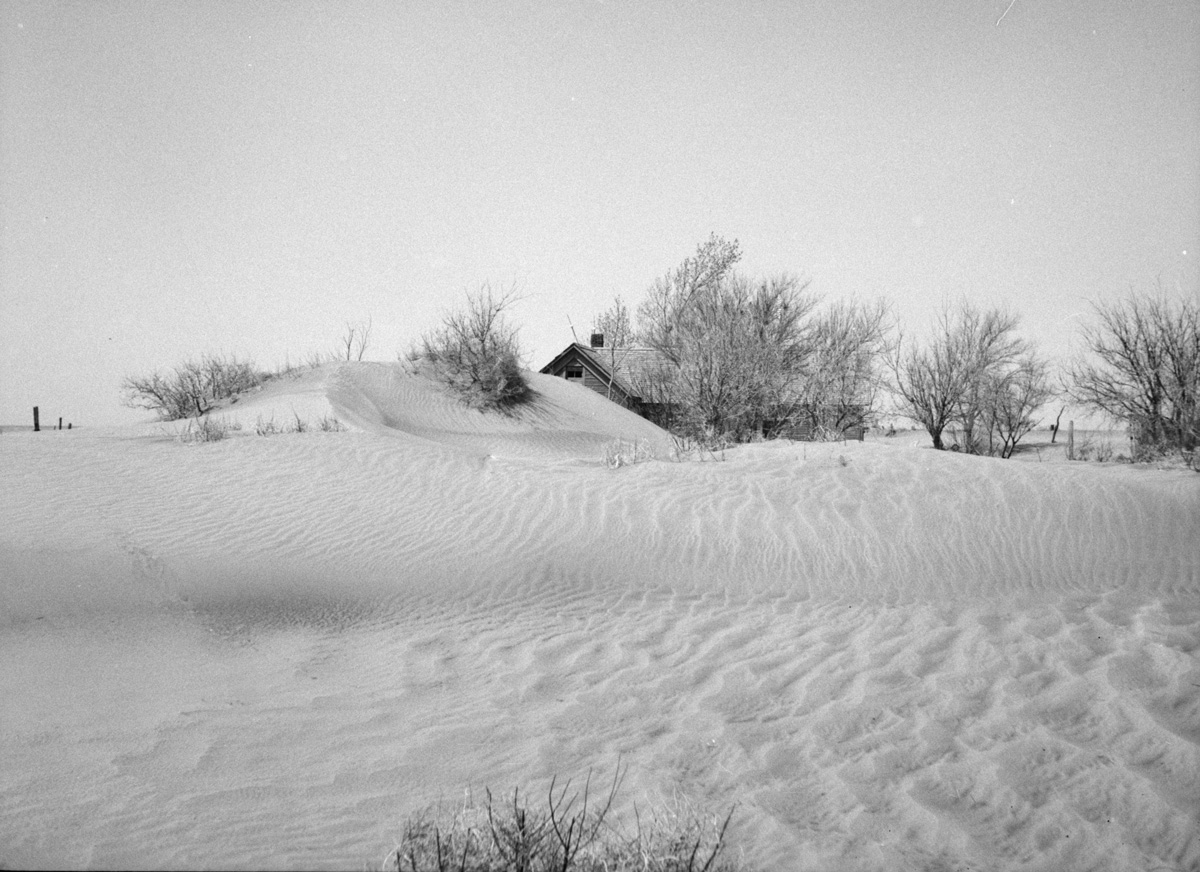
Severe wind erosion made this farm in Cimarron County, Oklahoma, uninhabitable. Photo by Arthur Rothstein, Library of Congress.
Nearly a century later, climatic conditions and those who endure them are again in the news as many farmers are enduring either flooding or drought. The high plains farming region is now planted in furrows, buffered by millions of trees, and heavily irrigated by deep aquifers, but its future (along with many marginal farming regions around the world) is not secure. Climatologists predict a drier future for many of the Dust Bowl states due to human-caused climate change. That means warmer temperatures and more dust storms, particularly in the Southwest and on the Southern Plains.
Climate expert Al Werner warns that, despite advances made since the Dust Bowl, many farmers would likely not be able to irrigate their way out of such a drought. The Ogallala Aquifer, which lies beneath eight Great Plains states and waters more than a quarter of the nation’s farmlands, is being depleted rapidly. “Some of that water is very old, and it’s not being replenished anywhere near the way it used to be,” he says. “It’s not sustainable. It’s likely in the future we’ll be facing more Dust Bowl conditions.”
“If there are any definite reasons for farmers to be hopeful, they would seem to lie in their habitual capacity for keeping at work in spite of failure and loss, their lifelong training in facing hard facts, their comparative adaptability,” Henderson wrote to Alden in 1932. At that time she and her family were fighting dust and facing a dismal future. They still had no radio, telephone, running water, modern refrigeration or lighting, but they had “shining memories to brighten gloomy days, and friendships beyond our deserving,” she wrote. “Perhaps in what many people would count ignoble poverty, we are rich after all.”
—By Heather Hansen ’94
Heather Baukney Hansen ’94 is an independent reporter splitting her time between Colorado and Cambridge (U.K.). Her most recent books explore wildfire in the American West and the environmental history of the United States.
This article appeared as “The Demands of the Soil” in the winter 2020 issue of the Alumnae Quarterly.
January 30, 2020


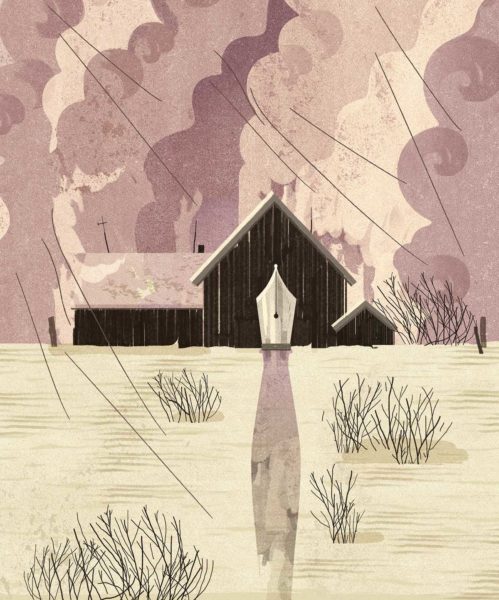








I am so impressed with this information and the incredible persons who endured. I’m 71 yrs old and I am truly thankful for this history I can read. I would love to see Caroline’s home and the vast prairie areas. I live in central Oklahoma.
I was born in the Texas Panhandle during World War II. We lived in Canyon Texas, and the Dust Storms did not end in 1940. After one such storm my mother recalled opening the refrigerator and finding dust covering the contents.
Professor Werner is right; the changes to agricultural practices have not made farming in the high plains sustainable. Agribusiness will not be able to irrigate when the Oglallah Aquifer is drained. Maybe then we can let the soil return to being the carbon sink it needs to be.
I knew a bit about the Dust Bowl, but having been born and raised in New York City, my family had no first hand connection to it. Caroline Boa Henderson’s letters have certainly put a startling face to the hardships and deprivation our mid-west farmers endured. Independent family farms have dwindled, falling prey to agribusiness; I tip my hat to those strong enough to continue in this heroic field.
thank you for this information about the Dust Bowl in Oklahoma –especially poignant as I lived IN Oklahoma from 1933 to 1951 and seldom heard people talk of this catastrophe except one sister in law who lived in middle of the State on her father’s truck farm.
She said their topsoil simply BLEW AWAY and affected their livelihood. She virtually left home at 17 tired of her father’s tough demeanor ordering her and her siblings to harvest vegetables in 100 degree summer and fall heat waves.. She became a nurse because you could go to school free if you committed yourself to then working for a hospital. That was in 1940’s.